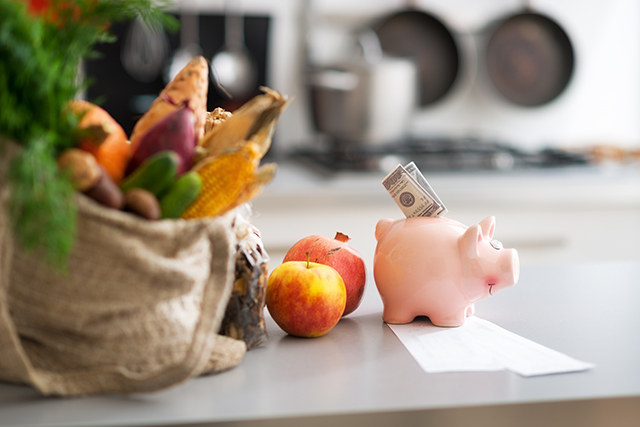Whether you are coeliac, gluten-intolerant or have gone gluten-free as a lifestyle choice, Charlotte Willis explains that it doesn’t have to be the wallet-emptier many believe it to be…

So you’ve made the decision to eliminate gluten from your diet. That was the easy part! What follows, for many of us, is the uncertainty of rediscovering and redeveloping our once simple relationship with the humble weekly grocery shop. Faced with the new task of full food label allergen analysis, combined with frustration at not being able to eat or drink previously favoured foodstuffs, and being bombarded by a choice of often more expensive free-from items that sees your receipt subtotal skyrocketing – it’s enough to leave you with a sense of anxiety and aggravation with your new diet! But take it from a seasoned expert, your gluten-free transition doesn’t need to be this way. Going gluten-free can help you improve your health drastically, and with a few handy tips, it won’t end up breaking the bank.
Don’t believe all you hear
The first frustrating thing that I’m asked by the majority of my friends and family members when I talk about my free-from lifestyle: ‘Isn’t that really expensive though?’ This is made even more frustrating given that it’s based on incorrect assumptions. People assume a free-from diet means you start shopping at the most exclusive shops and using fanciful ingredients. This isn’t helped by the expensive gluten-free foods on the market and, with a large number of companies choosing to create gluten-free ranges at a premium price, its easy to see how the public can be fooled into thinking going gluten-free will result in a hefty shopping bill.
Gluten-free & hassle-free
Let’s get a few things straight! When making the choice to become gluten – free, the best advice I can give to you is to re-think your diet as a whole, and this is where most new gluten-free converts go wrong. Instead of viewing your diet as (now) limited and your choice of food items being reduced to a certain section of the supermarkets or shops, see this change in eating habits as a healthy and refreshing chance to transition your diet towards a heightened level of nutrition.
Simple gluten-free substitutions and a few clever buying tricks will help your new gluten-free diet save you some serious dough (pun fully intended), whiLe avoiding compromise on nutrition and enable you to discover a new and delicious range of new and exciting free-from flavours.

1. The great gluten-free product trap
While it fills my heart with joy to see a new-fangled gluten-free product pop up on the market, it also makes me increasingly aware that many of us will become accustomed to simply reaching for easily identifiable pricier branded products. In fact, the average specialised labelled gluten-free product can be between 20-200% more expensive than it’s gluten-containing cousin. By relying on convenience, branded, gluten-free products, you could receive a nasty shock at the checkout!
Wherever you can, try to get creative in the kitchen and make your own versions of your favourite products! Gluten-free breads are common branded money drainers! You can batch-bake your own loaves of bread or bread rolls from naturally gluten-free ingredients using easy recipes (such as those found in this magazine) from online recipes and gluten-free baking books. Also, instead of reaching for a pre-made brownie or cake from the shelf, why not make your own sweet treats? Not only will you be able to get acquainted with the art of gluten-free baking, but you’ll often produce healthier, larger portions that can be frozen for a later date.
When it comes to gluten-free meals, step away from the ready-meal aisle! You’ll save yourself a fortune by prepping your own packed lunches and dinners, with any leftovers popped in a Tupperware for a later date. Try batch-cooking pies, soups and curries for easy-freezing. This way, you’ll be sure to have a quick meal in preparation for busier days.
2. Not knowing your carbohydrates
If you’re anything like me before I chose to live a free-from lifestyle, your main sources of carbohydrate might be white, beige and brown all over! Staples of the typical British diet rarely vary from refined wheat pastas, wheat-based breads, white potatoes and white rice. Yawn.
When selecting your carbohydrates as part of your nutritious and low-cost gluten-free lifestyle, opt for buying a range of different grains. Quinoa, polenta, buckwheat and coloured rice are extremely nutritious and diverse, costing very little when bought online and in bulk.
Sweet potatoes, squash and beetroot are healthier swaps for conventional white potatoes, and are often cheaper when bought in season. Try them as pie toppers, or add a tin of white beans to your mash to get an extra protein hit that’ll keep you fuller for longer.
Some of my favourite substitutes for wheat-based pastas include buckwheat, corn or rice pasta. Rice noodles work as a fabulous spaghetti alternative, or use raw veggies such as courgette and carrot to make a veg-based, lighter pasta alternative.
Personally, I have completely eliminated bread from my diet. But if you still crave the nation’s favourite staple carbohydrate, then try making your own! Short on time? Flatbreads made with buckwheat and quinoa flour can be knocked up in less than 30 minutes, or try making Indian dosa breads and chapatis.

3. Buying little and often
This is one of the most pivotal lessons I have learned from my free-from cupboard stocking over the years. Buying smaller quantities of grains, nuts, seeds and pulses will initially make economic sense. After all, why buy a huge 5kg bag of brown rice for £10 when I can buy a 500g bag for £1.50? Many of us will fall into this trap, making the mistake of adopting a little and often buying pattern. The average family in the UK will visit the supermarket as often as three times per week just to restock on staples that have run out by the middle of the week.
Buy non-perishable and longer-life items in bulk. Buying directly from wholesalers online, you’ll find that the cost per Kg will decrease when you purchase a higher weight of produce. This goes for grains, flours, legumes, pulses, seeds, nuts and dried fruits – all of which can last for months! Added bonus? You’ll save time by not making those extra trips to the supermarkets and save on packaging too.
4. Not getting enough veg
If you’ve already decided to give up gluten, the idea of reducing the amount of meat that you consume might seem like a step too far! But I would not be giving you the most honest advice if I wasn’t to mention the fact that an over-reliance on meat and meat-products in your diet, can actually end up costing you more than, say, being a flexitarian or vegetarian.
By increasing the amount of fresh vegetables and legumes/pulses in your diet as a substitute for meat, you’ll find both your health and bank balance will improve significantly! Gram for gram, plant-based protein is undoubtedly cheaper and easier to store and keep fresh than animal sources. What’s more, plant-based protein contains no cholesterol, little saturated fat and more often than not will provide you with higher levels of fibre and vitamins. Why not try incorporating a couple of meat-free days into your regular routine too? Simple and yet extremely cost-effective.
5. Wasting your food
One of my pet hates – food waste. The average household throws away £60 worth of food every month. That equates to around 24 main meals worth of food, simply thrown in the bin! While this attitude is not exclusive to those of us who are gluten-intolerant, it’s an issue that is definitely worth everyone’s consideration.
Before you do your shopping, do a mini household food review – a conscious stock-take of your fridge, freezer and cupboards that will ensure you utilise all your ingredients to their full potential. Ingredients that are going out of date can be paired with fresh products that will turn them into cheap and sustainable meals. By structuring your weekly shopping in this way, you’ll minimise food waste and save yourself money at the same time. Win win.
When you go grocery shopping, make a list and endeavour to stick to it. Avoid the multi-buy options or buy one get one half price, especially when it comes to fresh produce (unless you are certain you will use them well) as these offers lend themselves towards wastefulness.
Another waste-reduction tip is to use your freezer wisely. Far from a storage of ice cube trays and peas, your freezer can become a storage unit of leftovers, over-ripe fruits and veggies, herbs and ingredients that may be going slightly out of date. A perfect way of preserving nutrients and helping keep your costs low at the same time.
About the author
 Charlotte Willis is a student researcher of nutrition and human disease. Studying to become a Doctor of Human Nutrition, she is particularly interested in wholefood, plant-based nutrition and healthful lifestyle intervention in the prevention and reversal of chronic human diseases.
Charlotte Willis is a student researcher of nutrition and human disease. Studying to become a Doctor of Human Nutrition, she is particularly interested in wholefood, plant-based nutrition and healthful lifestyle intervention in the prevention and reversal of chronic human diseases.
